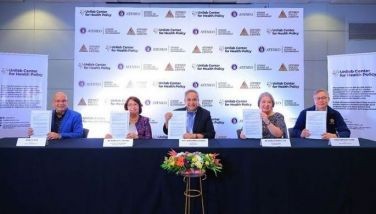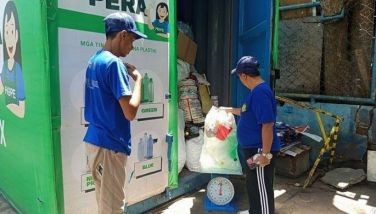Two milestones in responsible mining

Two recent events can be said to boost the advocacy for responsible mining. The Philippines has long been considered as one of the most endowed countries for its minerals. It is a God-given because it is along “a well-defined belt of volcanoes called the Circum-Pacific Rim of Fire where the processes of volcanism and plate convergence resulted in the formation of abundant and important metallic mineral deposits.â€
It could be among the top ten largest mining powers in the world: third in gold, fourth in copper, fifth in nickel and sixth in chromite. It could solve its economic problems that have taken its toll on its millions of poor but governance and proper implementation of its mining law stand in the way of developing the potential that is the envy of the world.
Such wealth can only benefit its teeming poor if it is managed responsibly. The prompt payment of a fine for P1.034 billion imposed on Philex Mining by the DENR and MGB for a tailings mining accident is a milestone for responsible mining. President Eulalio B. Austin Jr. handed the check to Environment Secretary Ramon S. Paje and Mines and Geosciences Bureau (MGB) director Leo L. Jasareno a day before the Feb. 19 deadline set by the MGB. Accidents happen and it is true of almost of any industry that benefits humankind. It is analogous to the question whether we should all call off air travel because an airplane has crashed.
The Philex tailings accident happened when unexpected rains caused the August spill. But the mining company Philex acted immediately to stave the results of the accident and has spent over P4 million for “remediation efforts’ in the affected areas.
* * *
The other milestone is the news that an ECC (an environmental compliance certificate) has been granted by the Department of Environment and Natural Resources to Sagittarius Mines Inc. (SMI).
This has been a long-standing commitment from the Philippine government to demonstrate sound policies for foreign investments that the country needs so badly. An ECC is given to mining operations when it has fulfilled the requirements of the “environmental soundness†of the company’s mining.
With the ECC, the company can now move on to begin commercial operations in 2019.
“Before the ECC was issued, we were required to come up with the Environment Impact Statement (EIS) which is composed of extensive studies on all aspects of the environment and the project’s possible impact,†John Arnaldo, corporate communications officer.
In its EIS, the company asserted that the open-pit mine of SMI would have no adverse impact on the environment, Arnaldo said.
“All efforts would be made to reduce the potential environmental impacts posed by the open-pit mine,†SMI said.
* * *
Of late Japan has been very active in bringing aid projects as well as cultural performances to the Philippines. Most noteworthy is Sumitomo’s First Philippine Industrial Park that will be the site of some 67 companies, among them Honda, Canon, Nestle and Philip Morris.
Although Sumitomo owns only 30 percent it is expected to acquire more as it expands the 349 hectare site.
On the cultural side, the Japanese embassy brought in the Naoshima, an all-women community puppetry troupe from the southern Japanese island of Naoshima. It performed Bunraku pieces “Dango Uri†(The Dumpling Peddlers), “Keisei Awa no Naruto Junreika no Dan†(“The Song of a Pilgrim†scene from “The Courtesan at Awa†and the “Ebisu Mai†(“The Dance of Ebisuâ€) among others. I wish I had gone to the UPCIS Noh Theater Ensemble prize winning play “Ang Paglalakbay ni Sisa, isang Noh sa Laguna†to show how a Japanese art form interprets a fictional tragic scene of Rizal’s mother when she was banished from their home in Calamba. Noh, a traditional form of Japanese theater.
* * *
The Traditional Cultural Festival by the Chinese Embassy in cooperation with the city government of Manila and the National Parks Development Committee opened to the public yesterday at the Chinese Garden of the Rizal Park. This is an annual event  and is now in its 11th year of cooperation.
Cultural groups from the City of Suzhou, including a 43-member cultural group will be there to showcase their talent in the week-long 12th China-Philippine Traditional Cultural Festival. Suzhou is on the Eastern part of China and adjacent to Shanghai.
It is known to the Chinese as a Paradise on Earth and has 2,500 years of history. Some of its products are already known to most Filipinos especially its silk products and handicrafts.
Suzhou is famous for its abundant resources and cultural legacy, traditional art, Kun Operas, Pingtan performances, and embroidery.
For the musical performance on stage, the City of Suzhou had selected and compiled various traditional folk arts, such as Kun Opera, Pingtan performances, traditional music of Jiangnan region (Jiangnan Sizhu ensemble), interpretation of Kun operas through puppetry, and many others.
The beautiful music of the Kun Opera has been listed as one of the “Masterpieces of Oral and Intangible Heritage of Humanity†by the United Nations Educational, Scientific, and Cultural Organization (UNESCO) in 2001.
World famous Suzhou handicrafts such as native embroidery fan, Taohuawu New Year wood prints, sculpture, and lanterns all from China “intangible heritage†of centuries of culture will also be on exhibit. Not only have these showcased the fine artistry of these native crafts, but also illustrates its long history as well.
Most of them have even existed during the Tang and Sung dynasties.
Two large lanterns, named “Crowing of the Golden Rooster†and “Fun at the Lily Pond†are also on exhibit to show the lasting friendship between China and the Philippines, two nations working together for a better future.
The Philippines should welcome the avid activity from both Japan and China in the Philippines as long as this is done in the spirit of true friendship between people to people. Exhibitions and cultural events are not peripheral to politics but constitute the basis of the real friendship between our countries. At the same time it must not impair our ability to act independently when it comes to crucial foreign policy decisions especially as it relates to the South China Sea conflict.
- Latest
- Trending




























